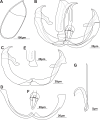Revisiting the type material of two African Diplozoinae (Diplozoidae: Monogenea), with remarks on morphology, systematics and diplozoid specificity
- PMID: 38435989
- PMCID: PMC10908257
- DOI: 10.7717/peerj.17020
Revisiting the type material of two African Diplozoinae (Diplozoidae: Monogenea), with remarks on morphology, systematics and diplozoid specificity
Abstract
The morphological characterisation of Diplozoidae spp. is highly reliant on the details of the sclerotised components of the hooks and clamps in the haptor. Only six species of Paradiplozoon (Diplozoinae) have been described from Africa, four of which have adequate morphological and even comparative ITS2 rDNA data available. However, the descriptions of Paradiplozoon ghanense (Thomas, 1957) and Paradiplozoon aegyptense (Fischthal & Kuntz, 1963) lack essential taxonomic information, specifically the details for their haptoral sclerites. As such, all available material from museum collections for these two species were studied using light microscopy to supplement the original morphometric descriptions. The holotype and paratypes of P. aegyptense were studied, but only voucher material for P. ghanense could be sourced. However, this voucher material for P. ghanense was deposited by the species authority and bore a striking resemblance to the illustrations and collection details from the original description. They were thus identified as the type series for the taxon, with a lectotype and paralectotype designated. Both P. ghanense and P. aegyptense could be readily distinguished from other taxa based on the supplementary data generated here, supporting their distinctness. The haptoral sclerites of P. aegyptense were most similar to those of Paradiplozoon krugerense Dos Santos & Avenant-Oldewage, 2016, also described from Labeo spp., while the sclerites of P. ghanense were most similar to Paradiplozoon bingolense Civáňová, Koyun & Koubková, 2013 and Paradiplozoon iraqense Al-Nasiri & Balbuena, 2016. Additionally, a voucher of P. aegyptense collected from the alestid type host of P. ghanense was reidentified as the latter species here. This greatly simplified the known host specificity for Paradiplozoon spp. in Africa, with P. aegyptense now exclusively reported from Cypriniformes (Cyprinidae and Danionidae), and P. ghanense restricted to Characiformes (Alestidae). The occurrence of all diplozoids from non-cyprinoid hosts was also investigated and several records of diplozoids occurring on non-cyprinoid hosts were collated and scrutinised. Excluding the two instances of diplozoids described and exclusively occurring on Characiformes fishes (P. ghanense and Paradiplozoon tetragonopterini (Sterba, 1957)), most other non-cyprinoid collections appear sporadic and unsubstantiated, but warrant further investigation supported by diligent taxonomic data. Even though the morphometric descriptions of both P. ghanense and P. aegyptense were fully reported on here, additional material will be needed to study their genetic profiles and phylogeny.
Keywords: Biodiversity; Fish parasite; Freshwater; Paradiplozoon; Platyhelminthes; Polyopisthocotyla.
© 2024 Dos Santos and Avenant-Oldewage.
Conflict of interest statement
Annemarie Avenant-Oldewage is an Academic Editor for PeerJ.
Figures


References
-
- Abdul-Rahman NM. Parasites infection in fish from Garmat Ali River and it’s relation with food items. 1999. M. Sc. Thesis. College of Agricultural—Basrah University.
-
- Ahmad F, Fazili KM, Sofi TA, Sheikh BA, Waza AA, Rashid R, Gani TT. Morphological and molecular characterization of Diplozoon kashmirensis; D. aegyptensis and D. guptai collected from fishes of Kashmir Valley-India. Fisheries and Aquaculture Journal. 2015a;6:1000147. doi: 10.4172/2150-3508.1000147. - DOI
-
- Ahmad F, Fazili KM, Sofi TA, Waza AA, Rashid R. Comparative molecular characterization of three Diplozoon species from fishes of Kashmir Valley. Agricultural Advances. 2015b;4:65–83. doi: 10.14196/aa.v4i7.1919. - DOI
-
- Ahmad F, Sofi TA, Fazili KM, Sheikh BA, Sofi OMD, Jaswal K. Comparative karyological analysis of three Diplozoon species (Monogenea, Diplozoidae), gill parasites of Schizothorax species—first report from the Kashmir Valley India. Scientia Parasitologica. 2015c;16:71–82.
-
- Aioanei F. Continental and peripheral lineages of monogeneans in fresh waters. Travaux du Muséum National d’Histoire Naturelle “Grigore Antipa”. 1996;36:391–424.
MeSH terms
LinkOut - more resources
Full Text Sources
Research Materials
Miscellaneous

